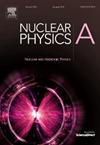研究沿N=49等音的入侵态的集体
IF 2.5
4区 物理与天体物理
Q2 PHYSICS, NUCLEAR
引用次数: 0
摘要
在N=49等音层(79Zn, 81Ge, 83Se, 85Kr)上,可以观察到源自中子穿过N=50壳隙的侵入态,其中83Se的能量最低。N=50壳层间隙向Ni方向的减小有利于这些态能量的降低。此外,由于Se核(Z=34)位于质子fp-壳层(28≤Z≤40)的中间,它应该具有最大的四极相关,从而进一步降低了这些变形构型的能量。这使得Se成为理解该区域粒子-空穴侵入态集体性的一个很好的候选者。这些信息也可以作为旨在描述78Ni附近区域的理论模型的试验场。本文报道了在LNL上测量83Se的540-keV 1/2+和1100-keV 3/2+侵入态寿命的实验。本文章由计算机程序翻译,如有差异,请以英文原文为准。
Investigating the collectivity of intruder states along N=49 isotones
Intruder states that originate from the promotion of neutrons across the N=50 shell gap are observed along the N=49 isotones (79Zn, 81Ge, 83Se, 85Kr), with the lowest energy in 83Se. The reduction of the N=50 shell gap towards Ni favors the lowering in the energy of these states. Moreover, since the Se nucleus (Z=34) is in the middle of the proton fp-shell (28≤Z≤40), it should have the maximum quadrupole correlations, lowering further the energy of these deformed configurations. This makes Se a good candidate for understanding the collectivity of the particle-hole intruder states in this region. Such information could also be used as a testing ground for theoretical models aiming to describe the region in the vicinity of 78Ni. An experiment aiming to measure the lifetime of the 540-keV 1/2+ and 1100-keV 3/2+ intruder states of 83Se was performed at LNL and is reported in this work.
求助全文
通过发布文献求助,成功后即可免费获取论文全文。
去求助
来源期刊

Nuclear Physics A
物理-物理:核物理
CiteScore
3.60
自引率
7.10%
发文量
113
审稿时长
61 days
期刊介绍:
Nuclear Physics A focuses on the domain of nuclear and hadronic physics and includes the following subsections: Nuclear Structure and Dynamics; Intermediate and High Energy Heavy Ion Physics; Hadronic Physics; Electromagnetic and Weak Interactions; Nuclear Astrophysics. The emphasis is on original research papers. A number of carefully selected and reviewed conference proceedings are published as an integral part of the journal.
 求助内容:
求助内容: 应助结果提醒方式:
应助结果提醒方式:


